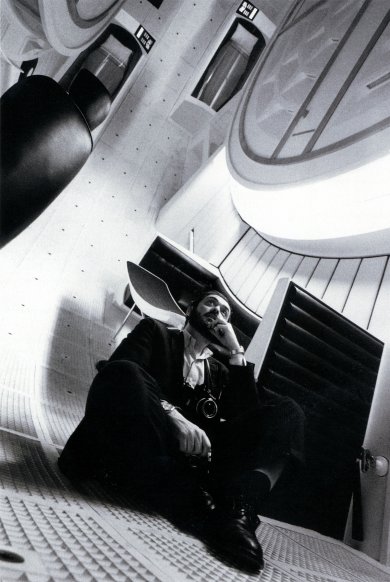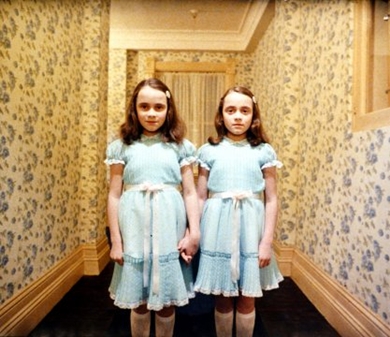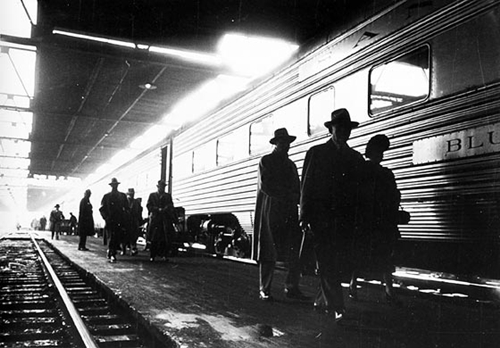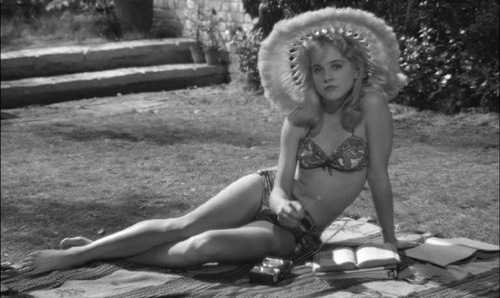
Director Stanley Kubrick sits in the interior of the space ship Discovery from “2001.” © Warner Bros. Entertainment
Acclaimed filmmaker Stanley Kubrick’s storytelling sometimes leaves me cold, but I’ve always admired his arresting images and balletic camera. I think his best movies are his classic noir and neo-noir titles – “Killer’s Kiss,” “The Killing,” “Lolita,” “Dr. Strangelove” and “The Shining.”
Born in New York in 1928, Kubrick began as a photographer. He had his first photograph published in Look magazine when he was 16 (he was paid $25). Later, as a Look staffer, he shot on city streets, often swathes of nighttime blackness pierced by patches of light. His desire for precision and painstaking quest for technical innovation started early and stayed with him for the next 55 years.
The range and richness of his art are explored in the first U.S. retrospective of his work, co-presented by the Los Angeles County Museum of Art (LACMA) and the Academy of Motion Picture Arts and Sciences.
The exhibition highlights Kubrick’s bond with film noir, noting: “In the title of his first feature film, ‘Fear and Desire’ (1953), Kubrick declared two themes that he would return to throughout his career. The atmosphere of film noir – its claustrophobia, paranoia and hopelessness – creates a worldview made more tangible through style: low-key lighting, high-contrast and silhouetted images, the blackest shadows. These characteristics of noir, together with the camera movements that would soon be identified with the director, were coherently articulated in Kubrick’s three early features.”
And later: “What Kubrick began with ‘Lolita’ (1962) – disrupting the conventions of film noir – he accomplished completely with “Dr. Strangelove” (1964). Kubrick made the decision to treat the story as nightmare comedy.”
Kubrick’s films, including “Paths of Glory,” “Spartacus,” “Dr. Strangelove,” “2001: A Space Odyssey,” “A Clockwork Orange,” “Barry Lyndon,” “Full Metal Jacket” and “Eyes Wide Shut,” among others, are represented through archival material, annotated scripts, photography, costumes, cameras and equipment, set models, original promotional materials and props.
In one of several letters rebuking Kubrick over the making of “Lolita,” the Bible Presbyterian Church of Tampa, Fla., decries that the movie “is based upon sex appeal. And that appeal is quite degenerate in its nature.”
There are also sections on Kubrick’s special effects and an alternate beginning to “2001” as well as displays about projects that Kubrick never completed (“Napoleon” and “The Aryan Papers”).
Kubrick died in 1999 in England, at the age of 70. He garnered 13 Academy Award nominations and “2001” (1968) won the Best Effects Oscar.
The exhibition, which runs through June 30, 2013, will be accompanied by a film retrospective at LACMA’s Bing Theater beginning this month.

From “The Shining” (1980): The daughters of Grady (Lisa and Louise Burns). © Warner Bros. Entertainment
To kick off the film retrospective, on Wednesday, Nov. 7, the Academy will present an evening of clips and tributes to honor Kubrick, hosted by actor Malcolm McDowell. The event will also launch the Academy’s Kubrick exhibition, which will be open to the public through February 2013.
As for the LACMA/Academy collaboration: “It is a taste of things to come when we open the Academy Museum of Motion Pictures in the historic Wilshire May Company building on the LACMA campus,” said Dawn Hudson, Academy CEO.












From FNB readers